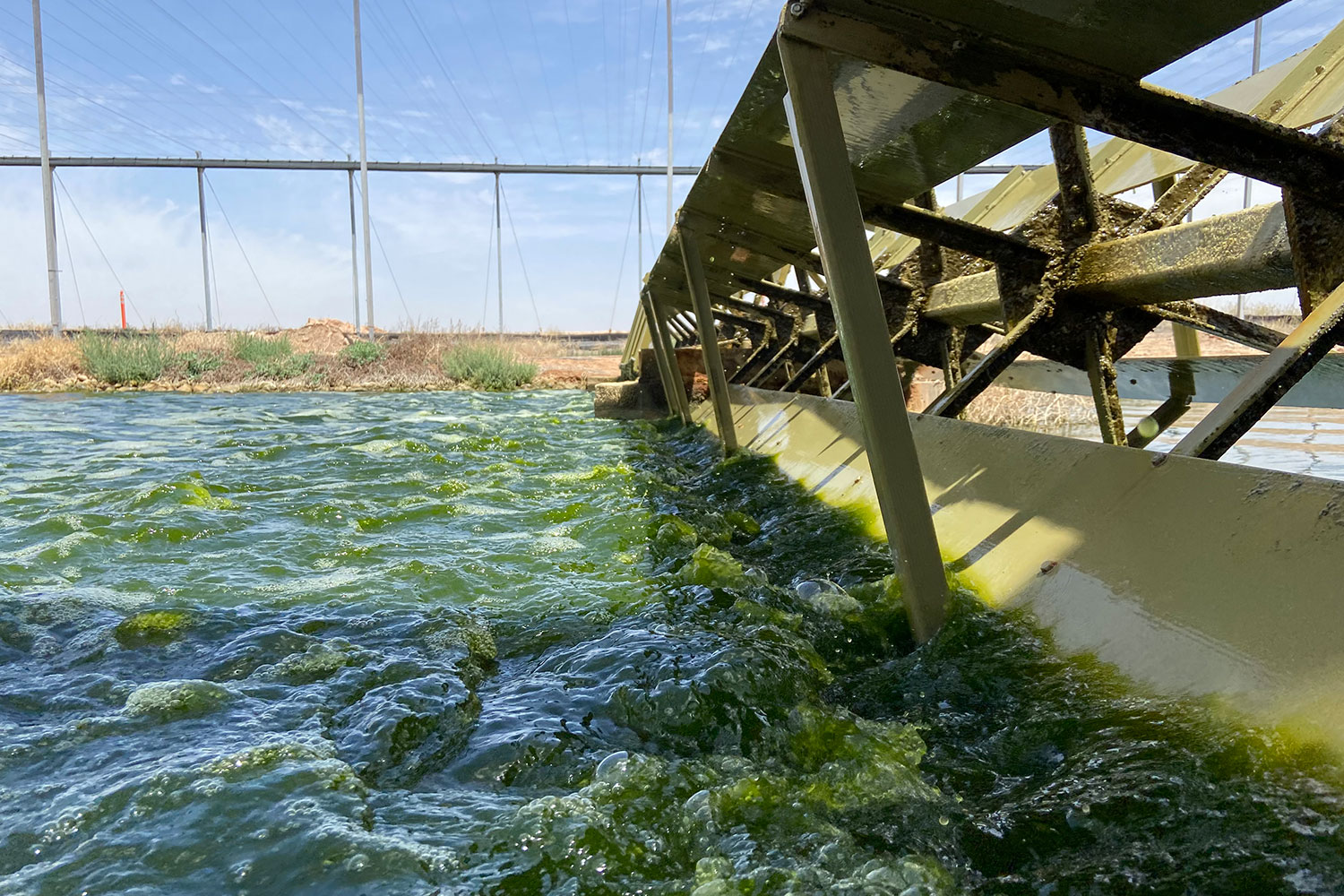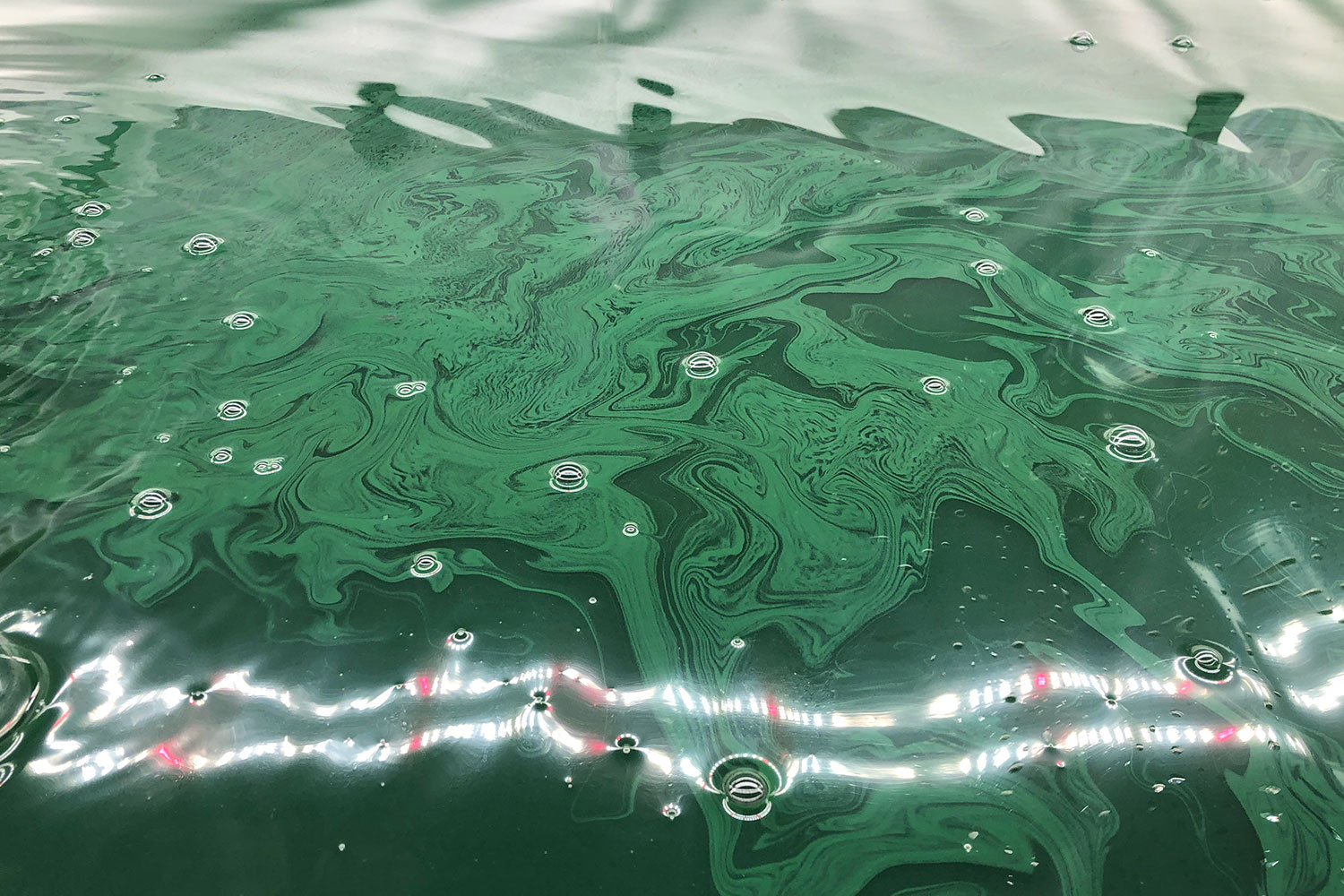As our climate changes, so will our diets. Fix is exploring that reality through the lens of foods that show what sustainable, equitable, and resilient eating could look like. Try them yourself with the recipes in our Climate Future Cookbook.
At first glance, the operations of We Are the New Farmers and iwi could not look more different. One occupies a 1,200-square-foot space in a warehouse on the waterfront in Brooklyn, New York, where a microscopic organism called Arthrospira platensis grows in stainless steel tanks illuminated by grow lights. The other sits on 300 acres of scrubland in West Texas, where a similar single-celled species thrives in brackish ponds surrounded by mesquite and javelinas. Despite the vastly different settings and scale, these companies are tackling the same challenge: producing food for a world in which fresh water and arable land are increasingly scarce.
With as many as 10 billion people crowding the planet by 2050, the world’s farmland, strained by extreme weather events, will be hard-pressed to churn out enough calories to feed everyone. It doesn’t help that the Western U.S. is seeing the worst drought in 1,200 years, and American farmers are experiencing lower yields and livestock forage as a result. Or that the U.S. has lost 11 million acres of farmland to development in the last 20 years.
Enter microalgae, a life form that, like a plant, gets its energy through photosynthesis. It can grow in fresh, brackish, or salt water, and it doesn’t need soil.
While most often used in animal feed and nutritional supplements, algae like the kind We Are The New Farmers and iwi grow is gaining attention as a sustainable food for humans. It is “a crop for people who want to turn climate-stressed land into more productive, more resilient forms of agriculture,” says Jonas Guenther, cofounder of We Are the New Farmers, which started producing Arthrospira platensis — more commonly known as spirulina — in 2017. The startup’s dark-green food product, which has the consistency of hummus, can add protein, vitamins, and minerals to anything from smoothies to veggie meatballs.
The wide range of possible environments and the speed with which the single-celled organisms grow leads Miguel Calatayud, the CEO of iwi, to call microalgae “kind of perfection.” His nutraceutical company plans to make it a central ingredient in a line of protein bars and drinks later this year. “It’s unbelievable, like it’s coming from a different planet,” he says. “This is really a revolution in farming.”
Growing algae

At iwi’s farm in West Texas, in a region where most conventional crops struggle to get enough water, the microalgae Nannochloropsis thrives. Iwi pumps brackish water from aquifers that have grown saltier over time from generations of agricultural use, and the algae love it. And since it’s grown in ponds, soil quality is irrelevant.
The growing process itself is also incredibly water-efficient. “It sounds counterintuitive because it grows in water,” says Guenther. During harvesting, the tank-grown spirulina makes several trips through a filter to remove more than 90 percent of the H₂O. The same goes for the Nannochloropsis grown in iwi’s open ponds. That reclaimed liquid nourishes the next round in a process that can be repeated several times.
Outdoor ponds inevitably lose more water to evaporation than indoor operations. “We can’t get around that,” says Jakob Nalley, iwi’s director of agronomy. But those losses are offset by how much protein algae provides with the relatively little water and land it requires, he says. One analysis found that microalgae yields between 22 and 44 tons of protein per hectare, depending on the region. That’s as much as 36 times the amount from soybeans. It helps that the entire organism is edible — algae has no stems, no roots, and no leaves. It also grows at a staggering rate; under ideal conditions, spirulina, for example, can double its biomass in as little as 48 hours.
[Read more: Insects offer a hyper-efficient, protein-rich food source — for our pets.]
“It’s explosive growth,” Guenther says. Given that, algae can be harvested as often as every few days. And indoor systems can be customized with the ideal temperature, light, and salinity levels for a given strain, making the yields even higher and more consistent throughout the year. (It’s even possible to grow it without any light at all.)
“Algae is pretty much the most efficient organism at converting sunlight into nutrients,” says Sean Raspet, cofounder and product developer at Nonfood, which produces a microalgae powder meant to supplement savory food dishes. Raspet and others also celebrate the crop’s minimal “resource footprint” — most operations do not use pesticides, and although they all require electricity to run, they don’t need fossil-fuel intensive equipment like tractors.
Eating algae

When Guenther first learned of spirulina in 2017, he recalls asking himself: “If we have this magic crop, if you will, why is it not something that we eat a lot more?”
Of course, you can’t eat the scum on the sides of a pool or poisonous algal blooms, but humans have been enjoying a handful of edible varieties for hundreds of years, if not longer. The Aztec harvested spirulina and ate it as a dried cake, and it has long been harvested from Lake Kossorom in Chad, as well as in many countries in Asia. But it is not a regular part of the modern diet in the Western world.
Guenther learned that microalgae’s primary market for humans is in the form of nutritional supplements, because many varieties are rich in omega-3 fatty acids and protein. Companies like EarthRise, Nutrex Hawaii, and iwi grow algae for exactly that purpose. But Guenter saw an opportunity to use algae as the foundation of a whole range of foods.
“We want to create a world in which microalgae is a staple in every kitchen, making any meal better, brighter, and more sustainable,” says Guenther.
The folks at Nonfood had a similar idea: The best way of expanding algae production, they thought, was to produce an appealing product consumers could easily add to most any dish. Nongredient, which is microalgae in powdered form, can be used in stews, curries, salads, and more, enriching them with protein and healthy fats. Cofounder Lucy Chinen says it has an umami flavor profile, and she compares it to nutritional yeast, a product vegans turn to for its savory, cheesy flavor.
Chinen isn’t aiming to create the next fake meat product. Algae stands on its own as both a historical food and something novel. “There’s a lot of talk … about meat replacements and stuff like that,” she says. “Nonfood is not really a replacement for anything.”
Scaling up
According to the Department of Energy, 139,886 square miles of land in the United States is suitable for microalgae ponds — a figure that does not include current cropland, forests, or environmentally sensitive areas. That’s larger than New Mexico. Although that analysis was aimed at expanding biofuel production, the fact remains there is plenty of land available to grow algae, regardless of its end use.
But a few hurdles need to be addressed for the algae industry to reach its full potential. Algae startups are tackling consumer barriers to embracing algae as a food by demonstrating just how many ways it can be eaten. Another barrier to seeing algae in more kitchens is its cost, but We Are the New Farmers believes it can make algae more affordable by increasing yields. It is experimenting with injecting carbon, which drives algae growth. They predict the increased productivity, along with expanding production, will bring down retail prices. Iwi, which uses about 20 percent of its ponds, hopes its new algae bars and drinks will bring production to full scale.
Guenther hopes that by 2050, one-fifth of protein consumed worldwide will come from algae. While most of it won’t be produced in high-density areas, like the New York warehouse his company occupies, he sees growing algae in cities as a way to decentralize the supply chain. “Instead of building one large facility somewhere in the middle of nowhere where it’s super cheap, I’d rather have six facilities close to a major population,” he says. “And if there’s one thing we learned during the pandemic, it’s that being reliant on just one single stream of output is not the best way of operating.”
No one is arguing algae will become humanity’s primary source of food. But there is a growing understanding among environmental scientists, algae producers, and consumers that the magical single-celled organism, which thrives pretty much everywhere, could be a critical part of our culinary future. “We believe in the potential of microalgae to reimagine how we eat,” says Guenther. He hopes for “a circular future in which what we consume supports — rather than depletes — the planet we live on.”
For any environment, from abandoned industrial buildings to regions where the water is too salty for terrestrial crops, there is a type of algae (and a type of growing method) that can work. And that versatility is its power. “We can bring farming to places in the world where farming wasn’t even a concept,” says Calatayud.
Correction: An earlier version of this article misspelled Jakob Nalley’s first name.
Read more from the Climate Future Cookbook:
- Cities are planting trees. Why not make them fruit trees?
- How eating invasive, and tasty, lionfish could save marine reefs
- How perennial wheat could reverse the damage of industrial agriculture





